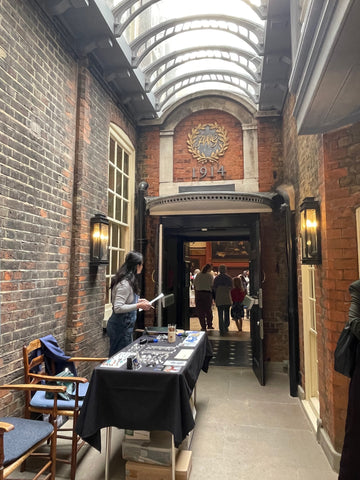The Art Workers Guild
Posted on
On Sunday I made a fascinating visit to The Art Workers Guild HQ.
The Art Workers Guild was set up by an eminent group of architects and designers in 1884 by well known names within the Art and Craft movement of the time including Gerald Horsley, WR Lethaby and Mervyns McCartney.
In the shadow of the industrial revolution, they were concerned at the growing chasm between architecture and art. They believed that artists had much to learn from architects and vice versa and The Guild was set up to provide unity within the visual and decorative arts.
Nowadays The Guild has 400 members ranging from architects to crafts people including ceramicists, photographers, jewellers, book binders, stone carvers, textile artists, illustrators. The list goes on. In their own words, the club is a Guild united by 'a respect for quality, for craftmanship, for work of the hand'.
The Guild is governed by a committee of members and presided over by The Master who is elected annually.
On Sunday, The Art Workers Guild hosted The Art of Making - an exhibition, demonstrations and talks as part of London Craft Week.
I took the tube to Russell Square and made the short walk to No 6 Queens Square, the 18th Century townhouse home to The Guild. Nestled amongst the medical institutions that the area is famous for, the townhouse stands proudly as a building dedicated to the arts. The building is adorned with lamps depicting the letters AWG and the words The Art Workers Guild are carved above the door.
Enter the building, and you have a distinct sensation that you have walked into a different era. On the left is The Masters Room and in front of you a black and white tiled hallway worn by the passing feet of it's members. The hallway leads into a vaulted glazed-roof courtyard to the Art & Crafts style meeting hall designed by Francis Troup in 1914. Scattered around are antique pieces of handcrafted chairs and tables.

Vaulted courtyard leading to Art & Crafts style meeting hall
But this is not a different era, but an historical setting. Throughout the rooms, makers were showcasing their pieces and demonstrating their practices proving that traditional skills that might have disappeared are very much alive.
In The Masters Room, I admired Prue Cooper's slip decorated, press-moulded earthenware depicting characters and/or inscriptions commenting on life. On a nearby table, Phil Abel was showcasing the craft of printing and publishing with his exquisite fine press, limited-edition books printed by his publishing company, Hand and Eye Editions.

Earthenware slipware by Prue Cooper

Window in the Willows published by Hand and Eye Editions
The lecture hall was buzzing with Guild members demonstrating their craft watched over approvingly by the portraits and busts of some of the bygone Masters - Sir Emery Walker and William Morris to namedrop a few. Jeremy Nichols was demonstrating the making and constructing of a teapot. Peter Hayes displayed his ceramic forms sculpted to evolve with the landscape. Phil Surey demonstrated the art of brush lettering using the classical Roman Trajan script and exhibited his stone sculptures with playful lettering.

Peter Hayes landscape sculpture

Jeremy Nichols ceramics
It is truly great to see a Guild that was founded over 100 years ago thriving. With a heightened recognition of the healing, human value of craftsmanship The Guild members are enjoying a renaissance. Long may these traditional skills be handed down to generations and long may these skilled makers continue with their mantra of 'learning by doing.'
Share this post
- 0 comment
- Tags: architecture, Art and Craft movement, book binders, book publishers, bookbinding, ceramics, craft, craft makers, craftmanship, craftsmanship, handcrafted, illustrators, jewellers, London Craft Week 2023, photographers, photography, Simon Taylor ceramics, Sir Emery Walker, stone carvers, stone carving, textile artists, William Morris
